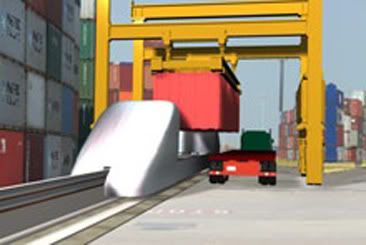I know I often write about the future, but I keep finding reasons to be excited about it – and anyway, it’s nice to expect the future to be better than the present. (It certainly beats the alternative.) I suppose this is the definition of an optimist.
Today this optimist is excited because the Ports of Los Angeles and Long Beach, along with the Alameda Corridor Transportation Authority (ACTA), have issued a Request for Concepts and Solutions (aka the “RFCS”) for a Zero-Emissions Container Mover System (aka a “ZECMS”) to serve port-related cargo operations. This Request, or RFCS, has been a long time coming, and I’m glad to finally see it. Interest in advanced, low- or zero-emissions technologies to move freight has been growing for several years, particularly in Southern California with its neighborhoods so directly impacted by freight movement. Given these impacts, community interest in zero-emissions technologies has been particularly acute and sustained.
Alternative systems proposed to move containers vary in cost, sophistication, complexity, and market-readiness. Some travel overhead while others remain at ground level. The ones I’ve heard of include blimps, barges, magnetic levitation (“maglev”) systems, other types of linear induction motor-driven vehicles, dual-purpose vehicles that can go on fixed guideways or streets, and plain old electricity applied to traditional trucks and trains as well as to newer-fangled vehicles. I’m sure still others will come forward in response to this request.

One alternative technology concept for cargo containers
Part of the reason that it’s taken a while to see this RFCS is that for roughly the last two years, the ports have been studying and evaluating a range of alternative advanced technologies for container movement, in an attempt to understand what the market has to offer. They seem to have settled on a “Concepts and Solutions” approach in recognition that the field of advanced container movement technology is wide-open and evolving. The would-be technology providers have been awaiting – with varying degrees of patience – a formal opportunity to show our ports the services they can provide. A central challenge for most of them is to not only identify, but also acquire, an appropriate right-of-way in our tangled, congested urban area. Another is to demonstrate how the systems will mesh with the existing configuration of port terminals and near-dock facilities.
Since readers often, and rightly, ask about money, I’ll mention that the Request asks that the submitted concepts involve no net cost to the ports and ACTA. Additionally, the ports will use the submittals, due in September, to evaluate the viability and feasibility of the available technologies, as well as the ability of the management teams to move to the next stage, which could involve more detailed competitive bidding on a system.
This week also saw the launch of a shore-power system at Pier T in Long Beach, the crude oil terminal used by British Petroleum. Shore power – also called cold-ironing – allows the use of dockside electrical power to run a vessel’s systems while it’s berthed, eliminating substantial pollution from the ship’s engines. The BP system took a few years to deliver, but its use is an eloquent demonstration that innovative technologies can be deployed and can help improve the environment. Our ZECMS may also be a few years away – some might say more than that – but this week’s request is a critical first step on the pathway there.
